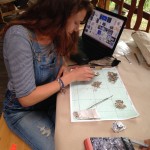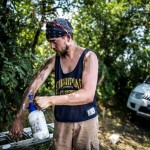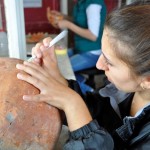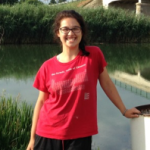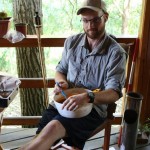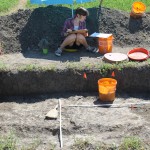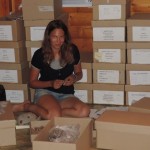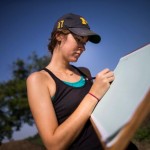NSF REU (Research Experience for Undergraduate)
2018 Participants
Da nte Renne Ayala
nte Renne Ayala
Moreno Valley College
“Bronze Age Burials from the Carpathian Basin: New Isotope Results” by Julia Giblin, Dante Ayala, Vajk Szeverényi, Tamás Hajdu, Gabriella Kulcsár, and Viktória Kiss:
Material culture, burial customs, and isotopic data have been used to suggest that the Bronze Age in the Carpathian Basin was characterized by high levels of human mobility; however, the extent to which people in this region migrated and travelled, and its relevance to questions regarding culture change, remain unresolved. In this study, we present new isotopic results collected from cemeteries of the Bell Beaker, Kisapostag, Vatya, Füzesabony and Tumulus cultures; assemblages that span the entirety of the Bronze Age in Hungary. Multiple isotopes (Sr87/Sr86, δ18O, and δ13C) were analyzed from tooth apatite samples from inhumation burials (n=95) and archaeological fauna (n=53). Results are compared to regional isotopic estimations for eastern and western Hungary, as well as previously published data for earlier time periods.
(Abstract submitted to the Society for American Archaeology conference in April 2019)
Zach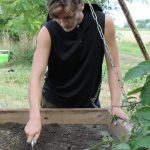 ary Beau Bible
ary Beau Bible
Maryville College
“Styles for Miles: A Regional Analysis of Ceramic Design Elements in Bronze Age East Hungary” by Ákos Mengyán, Zachary Bible, Paul. R. Duffy, and Györgyi Parditka:
Variation in ceramic design elements often informs two different kinds of stories—first, about the intentional and conscious displays on the part of the potters, and second, about the habits and unintended consequences of learned traditions in communities of practice. This poster investigates ceramic stylistic patterning at Békés 103, a Bronze Age (late second millennium BC) cemetery on the Great Hungarian Plain in the Eastern part of Hungary. We document specific design elements (such as bosses, channels, nodes, and prows) among the vessels and compare them to assemblages from three Bronze Age sites within 15 km of the cemetery known from previous surface collections. Our aim was to look for similarities and differences between sites in the width, height, and depth of design elements, a form of variation created as the unintended consequence of learned traditions. We find both evidence of likely unintended differences between potting communities, in addition to conscious differences in motif use between assemblages, a pattern probably informed by the identities and conscious decisions of potters.
(Abstract submitted to the Society for American Archaeology conference in April 2019)
Heleinna Abigael Cruz
Quinnipiac University
“Burning Beyond Color: Analysis of Bone Calcination in Cremated Burials from Bronze Age Hungary” by Heleinna Abigael Cruz, Réka Péter, Jaime Ullinger, Julia Giblin, László Paja:
Trade and movement may have been great factors in the changing societal landscape of Bronze Age Hungary, leading to possible inequalities among the people. Examination of burials can help us get to know the relation between a community and their dead which can be referred to the social connections of the community. With the acquired knowledge, we can better understand Bronze Age societies, especially on a period where many changes have taken place in society. The Békés 103 site located in Eastern Hungary proves valuable as it was occupied from the Early Bronze Age to the Late Bronze Age. This study focuses on the bone color analysis of 20 human burials with differing ages and sexes. The Munsell Soil Color Charts were used to objectively score the color of the bone fragments which may be able to indicate the temperature of the funeral pyre. Preliminary results suggest that subadults and females had a higher calcination percentage than adults. The amount of calcination amongst groups may indicate differences between mortuary practices in the Békés 103 cemetery which allows us to question about funeral practices and differences within society.
(Abstract submitted to the Society for American Archaeology conference in April 2019)
 Erika Bunnine Danella
Erika Bunnine Danella
Quinnipiac University
“Distribution of Cranial and Postcranial Elements in Bronze Age Cremation Urns from Eastern Hungary” by Erika B. Danella, Kylie Williamson, Jaime Ullinger, Julia Giblin, László Paja:
Located in the Köros region of Hungary, the site of Békés 103 contains a Bronze Age cemetery in which the majority of burials are cremations deposited in funerary urns. Despite the challenges posed by studying cremated human remains, they still provide a wealth of information regarding mortuary practices. Previous literature suggests that the measurement of skeletal weight across microstratigraphic levels within the urn can reveal insight towards the process of secondary deposition. In this study, we investigated the correlation between cranial and postcranial weight throughout the microstratigraphic levels in order to examine skeletal distribution within ceramic funerary urns. Pearson correlation and regression analysis demonstrate significant positive correlations between cranial and postcranial weight in four burials (n = 25). Instead of concentrating the cranial elements at the top or bottom of the urn, the cranial and postcranial elements seem to be scattered throughout. Therefore, our results suggest that there was not a systematic arrangement of cranial versus postcranial elements within the urn. In the future, we hope to individually plot the distribution of bone fragments within two urns that have been piece plotted. Overall, this study aids in enhancing the understanding of Bronze Age cremation practices in southeastern Hungary, which can ultimately contribute to the study of social complexity and inequality in prehistory.
(Abstract submitted to the Society for American Archaeology conference in April 2019)
Cr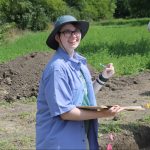 ystina Marie Friese
ystina Marie Friese
University of New Hampshire, Durham
“Burning Up and Breaking Up: Understanding Heat-Induced Bone Modifications in a Hungarian Bronze Age Cemetery” by Crystina Friese, Jaime Ullinger, Julia Giblin, László Paja:
In an attempt to better understand how social inequality manifests itself in Middle Bronze Age Hungary, the Bronze Age Off-Tell Archaeology (BAKOTA) project has been researching a cemetery in the Körös region of Eastern Hungary. The individuals in the cemetery appear to have been buried in a consistent manner, mostly cremated and placed in urns regardless of age. Prior research shows that cremated remains have various fracture patterns that may relate to how the body was prepared pre-burning. This poster focuses on comparing the presence of certain types of heat-induced bone modifications (i.e., longitudinal, curvilinear, and transverse fractures, patina, and warping) between adult and subadult burials to determine whether they were cremated using different practices. Based on a sample size of 14 human burials, results suggest that adults and subadults were not burned differently, as they exhibited no statistically significant differences in fracture patterns. This may suggest that bodies would have been positioned in a similar manner on a funeral pyre regardless of age, causing similar fracture presence when burned. These tentative conclusions contribute to the discussion surrounding the usefulness of the analysis of heat-induced bone modifications in determining social practices.
(Abstract submitted to the Society for American Archaeology conference in April 2019)
Alyssa 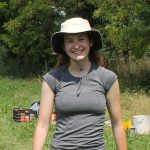 McGrath
McGrath
University of Notre Dame
“Chemical and Mineralogical Examination of Surface Encrustations on Middle Bronze Age Pottery from Békés 103, eastern Hungary” by Alyssa McGrath and Mark Golitko:
Ceramic sherds found at Békés 103, a primarily Middle Bronze Age cemetery on the Great Hungarian Plain, are often covered in a dense white concretion that must be removed before restoration and study of the vessels commences. These white concretions complicate further study of ceramic provenance and residue analysis at the site. We use a combination of pXRF, EPMA, FTIR, and LA-ICP-MS on ceramics and soil samples taken in association with these vessels to understand the composition of these concretions and how sherds have interacted with their burial environment. Hypothesized sources include cremated bone and post-burial uptake of soil phosphate. Knowledge of the chemical composition of these surface concretions will allow further study of how the burial environment of the Békés 103 ceramics impacts their paste composition.
(Abstract submitted to the Society for American Archaeology conference in April 2019)
Aras Ja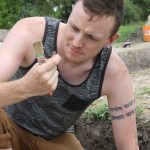 mes Troy
mes Troy
George Mason University (Fairfax Campus)
“Identifying Differences in Funerary Practice from the Distribution of Fracture and Warping Found on Cremated Human Remains at a Bronze Age Cemetery” by Aras J Troy and László Paja:
Research at the Békés – Jégvermi kert (Békés 103) site and similar sites in the Lower Körös River region of Hungary have yielded evidence that the Middle Bronze Age peoples of the region did not undergo substantial social stratification, despite evidence to the contrary from contemporary sites. Stratification of social systems can be identified in both material culture and human remains, particularly in mortuary practices. The burials at the Békés 103 cemetery reveal different mortuary rites, but the majority of graves are characterized as urn cremation, where ceramic vessels were buried in shallow graves. Bone remains from five single urn burials were analyzed for identifying characteristics of heat-induced fractures and structural disturbance associated with heating, such as warping. The types of fractures and modifications were recorded and separated into four categories grouped by association with possible evidence of the pre-incineration status of the body. With strongly correlated distributions of heat-induced alteration between burials, the sample largely provided evidence of uniformity between burials, supporting the conclusion that the individuals were cremated in a similar pre-incineration state. The results of our study add to previous research identifying factors relating to the social composition of the Great Hungarian Plain during the Middle Bronze Age.
(Abstract submitted to the Society for American Archaeology conference in April 2019)
Tere sa Godinez
sa Godinez
California State Polytechnic University, Pomona
“Channeling the Stylist Within: A Comparative Analysis of Bronze Age Ceramic Design Structure in Eastern Hungary” by Teresa Godinez, Paul R. Duffy, Györgyi Parditka:
The design structure—or position of individual design elements—has the potential to highlight social boundaries and the degree of interaction between potters in a comparative analysis of ceramics. This poster focuses on the design structure of ceramics from the Békés 103 site, a Middle Bronze Age (1600-1280 calBC) cemetery in eastern Hungary. We first try to determine whether elements such as channeling, bosses, and specific motifs such as spirals occur only on particular parts of the ceramic vessels at Békés 103. We then broaden the investigation of design structure by comparing the results from Békés 103 to a contemporaneous nearby cemetery, Csanytelek-Palé. We attempt to identify differences in the design structures of the two cemeteries that may result from social boundaries, despite the shared sets of individual design elements found between them.
(Abstract submitted to the Society for American Archaeology conference in April 2019)
CEI (Central European Institute) students
Á kos Mengyán
kos Mengyán
Eötvös Loránd Tudományegyetem
“Styles for Miles: A Regional Analysis of Ceramic Design Elements in Bronze Age East Hungary” by Ákos Mengyán, Zachary Bible, Paul. R. Duffy, and Györgyi Parditka:
Variation in ceramic design elements often informs two different kinds of stories—first, about the intentional and conscious displays on the part of the potters, and second, about the habits and unintended consequences of learned traditions in communities of practice. This poster investigates ceramic stylistic patterning at Békés 103, a Bronze Age (late second millennium BC) cemetery on the Great Hungarian Plain in the Eastern part of Hungary. We document specific design elements (such as bosses, channels, nodes, and prows) among the vessels and compare them to assemblages from three Bronze Age sites within 15 km of the cemetery known from previous surface collections. Our aim was to look for similarities and differences between sites in the width, height, and depth of design elements, a form of variation created as the unintended consequence of learned traditions. We find both evidence of likely unintended differences between potting communities, in addition to conscious differences in motif use between assemblages, a pattern probably informed by the identities and conscious decisions of potters.
(Abstract submitted to the Society for American Archaeology conference in April 2019)
Réka Pé ter
ter
Eötvös Loránd Tudományegyetem
“Burning Beyond Color: Analysis of Bone Calcination in Cremated Burials from Bronze Age Hungary” by Heleinna Abigael Cruz, Réka Péter, Jaime Ullinger, Julia Giblin, László Paja:
Trade and movement may have been great factors in the changing societal landscape of Bronze Age Hungary, leading to possible inequalities among the people. Examination of burials can help us get to know the relation between a community and their dead which can be referred to the social connections of the community. With the acquired knowledge, we can better understand Bronze Age societies, especially on a period where many changes have taken place in society. The Békés 103 site located in Eastern Hungary proves valuable as it was occupied from the Early Bronze Age to the Late Bronze Age. This study focuses on the bone color analysis of 20 human burials with differing ages and sexes. The Munsell Soil Color Charts were used to objectively score the color of the bone fragments which may be able to indicate the temperature of the funeral pyre. Preliminary results suggest that subadults and females had a higher calcination percentage than adults. The amount of calcination amongst groups may indicate differences between mortuary practices in the Békés 103 cemetery which allows us to question about funeral practices and differences within society.
(Abstract submitted to the Society for American Archaeology conference in April 2019)
Research Assistants
Nicole Oster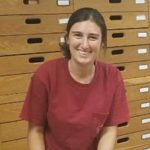
University of Georgia Alumni
After receiving my bachelor’s degree in Anthropology and Classics from the University of Georgia, I was fortunate enough to spend my summer working on the BAKOTA project. My role mainly consisted of site photography and general support within the field. Although I am currently unsure where the future will take me, I am extremely grateful to have worked with such an enthusiastic and fun team throughout this past season.
2018
 Morgan Wynne Robins
Morgan Wynne Robins
University of Wyoming Alumni
2018
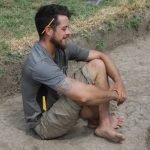 Nicholas Triozzi
Nicholas Triozzi
My primary roles this summer were to create scaled plan and profile maps of exposed archaeological features and to render 3D models of reconstructed burial urns and offering vessels. Working with the field directors, we coordinated a workflow for field-based photogrammetry. As a result, we created scaled 3D models of entire excavation blocks at each level as well as in situ burial contexts. Other highlights of the field season include helping to secure and remove urns for excavation in the lab and running a QGIS tutorial for students and volunteers. My dissertation research is focused on the Neolithic and Bronze Age transition in the Eastern Adriatic; working in the Carpathian Basin with the BAKOTA project was an excellent learning opportunity for me.
Penn State University
2018
I was incredibly happy to be invited back to the BAKOTA Project in 2018, which marked my third year on the Project. I am currently finishing my undergraduate studies at the University of Cincinnati, from where I will be graduating with Majors in Archaeology (Social Complexity), Anthropology, German Studies, and Biological Sciences. This was my first year on the Project where I was present in a Research Assistant role, instead of as an REU student. I spent most of the field season working in the database, and keeping track of and filling out paperwork associated with excavation. The BAKOTA Project has been a staple of my undergraduate education, giving me phenomenal opportunities to do archaeological research on Bronze Age metallurgy in the field, present that research at conferences, and now to take a peek behind the curtain to better understand the mechanics of archaeological excavations. I am grateful for all of the time I’ve been able to spend on this amazing project, and can’t wait to see what is discovered in the future!
2015, 2016, 2018
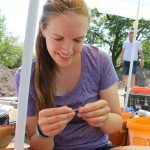 Kylie Williamson
Kylie Williamson
University of Florida
I was excited to head to my third season with the BAKOTA project this summer, which has provided me with invaluable field experience and mentorship. I am a bio-archaeologist working towards my PhD at the University of Florida. My research there has focused mainly on prehistoric Florida populations from the Middle Woodland period. I am most interested in isotope analysis to decipher mobility patterns and prehistoric diets, as well as ritual mortuary and burial practice analysis. This summer, I spent most of my time in the lab prepping the collection for student projects, but was also able to sneak into the field a few times for some fun micro excavations!
2015, 2016, 2018
2016 Participants
Robert Barlow
University of Alabama
“Spiraling like a Boss: Exploring elements of Bronze Age ceramic style at the micro-regional level” by Robert Barlow, Hajnal Szász, Györgyi Parditka, and Paul R. Duffy:
Fortified tell site excavations in the 20th century formed the basis for construction of a Bronze Age chronology in the Carpathian Basin. Typological and stylistic elements observed on these sites were used to create archaeological cultures for large areas, whose distributions changed over time. However, the use of large archaeological groups obviously masks internal regional variation, both chronologically and stylistically. Different river-valleys, as micro-regions, may have formed the basis for regular interaction, community activities and social practices, and thus may have left distinctive material culture. In this poster we compare stylistic elements of four different micro-regional areas in Eastern Hungary during two Bronze Age cultural phases. We evaluate the possibility that the large culture area names “Ottomány” and “Gyulavarsánd” mask internal variation recognizable among the surface collection material for 17 sites in the Lower Körös Basin. By considering other settlement types as well, we also investigate whether fortified tell sites provide a representative picture of regional ceramic manufacturing practices.
(Abstract submitted to the Society for American Archaeology conference in April 2017)
 Audrey Choi
Audrey Choi
Wellesley College
“Identifying pre-incineration state from heat-induced fracture and warping patterns found on human cremains in a Hungarian Bronze Age cemetery” by Audrey Choi, Jamie Ullinger, and László Paja:
Attempts to determine the status of human remains prior to their final deposition are complicated in the analysis of cremains. Forensic and archaeological studies, however, have advocated for the interpretation of heat-induced fracture and warping patterns as indicators of the pre-incineration state of the body and of the characteristics of the funeral fire. The purpose of this research is to examine the possible internal social structures of a Bronze Age population in the Körös region of Eastern Hungary by testing whether or not trends in the distribution of macroscopic heat-induced features exist across the cemetery site of Békés 103. Fragments from fourteen cremation urns were assessed for the presence of diagnostic fracture and warping patterns according to their anatomical region. Their relative frequencies were then compared among human burials, among urn layers, and among individual bone fragments that exhibited colors possibly indicative of temperature exposure. Results reveal that statistically significant differences in the frequencies of a few features, such as postcranial warping and “thumbnail” fractures, exist and may suggest the presence of discrepancies in bone biomechanics and/or funerary preparations within the examined sample of Békés 103.
(Abstract submitted to the Society for American Archaeology conference in April 2017)
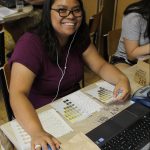 Heleinna Abigael Cruz
Heleinna Abigael Cruz
Quinnipiac University
“Bone Calcination of Different Age Groups in Cremations from Bronze Age Hungary” by Heleinna Abigael Cruz, Jamie Ullinger, and László Paja:
Bronze Age Hungary saw the advancement of trade which may have been a cause of the movement from egalitarian societies to more complex societies with increasing social inequality. Social inequality between regions in Hungary may be reflected in variation among funeral customs. Excavations from Békés 103, a Bronze Age cemetery in south-eastern Hungary, have uncovered 68 burials, most of which are cremations. This study focuses on color analysis (identified by Munsell Soil Color Charts) of the burned human bone from eleven cremation urns. Age may play a role in status differentiation, therefore subadults and adults were compared for level of calcination, indicating complete loss of the bone’s organic matrix due to the pyre’s high temperature. Preliminary results show a possible difference in calcination between subadult and adult cremations. Given that burials with greater calcination may indicate more energy being used in the maintenance of a funeral pyre; this suggests that age may play a role in mortuary behavior. These results may be helpful in understanding funerary customs of the Körös region when compared with the ceramic data associated with the burials.
(Abstract submitted to the Society for American Archaeology conference in April 2017)
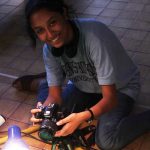 Hamima Halim
Hamima Halim
Johns Hopkins University
“Death Games: Exploring the Békés 103 Cemetery Using 3D Technology” by Gustavo Cerquera Benjumea, Hamima Halim, and Paul R. Duffy:
3D modelling has become an important tool in the distribution and analysis of archaeological data. This technology also has the potential to make archaeological information more widely available to the public. The goal of this project was to develop an interactive 3D environment based on the Békés 103 cemetery in the Körös region of eastern Hungary. This environment allows users to navigate the site in the first person while examining the burial practices of the Bronze Age people who populated this site. To accomplish this, 3D models of exposed cremation urns and restored vessels were created using a combination of photogrammetry and video production techniques such as green screen, rotoscoping, and Adobe’s AfterEffects software. Video production techniques were introduced to the process in order to maximize efficiency in a limited timeframe. Completed models were later incorporated into a 3D environment developed with the Unity game engine. This project can be helpful in demonstrating how 3D technology can be an effective way of collecting, disseminating, and promoting archaeological knowledge.
(Abstract submitted to the Society for American Archaeology conference in April 2017)
 Craig Jensen
Craig Jensen
Aquinas College
“Ceramics provenience: chemical analysis of ceramics and clays in Eastern Hungary via LA-ICP-MS” by Craig Jensen and Mark Golitko:
This project explores the provenience of ceramics found at the Bronze Age Békés 103 cemetery. By answering the question of where these ceramics came from, it is possible to hypothesize which Bronze Age communities used the cemetery. To do this, clays were collected throughout Eastern Hungary for chemical analysis. Clay is often found along river banks, but many modern rivers may have been polluted. Instead, paleo-meanders of modern rivers were chosen as collection sites; these were identified using QGIS. This revealed the chemical variability found throughout the region. Then, by comparing the chemical composition of the clays to that of the Békés 103 ceramics, the farthest possible extent of cemetery usage was determined. Preliminary analysis of the clays was performed using XRF. Both the ceramics and the clays were analyzed by LA-ICP-MS.
(Abstract submitted to the Society for American Archaeology conference in April 2017)
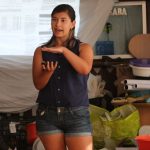 Emily Quarato
Emily Quarato
University of Alabama at Birmingham
“Burning Questions about Preservation: An investigation of Cremated Bone Crystallinity in a Bronze Age Cemetary” by Craig Jensen and Mark Golitko:
The elemental and isotopic analysis of human skeletal remains has greatly added to our understanding of diet, mobility, and social variability in prehistoric societies. For studies of this nature, it is critical to evaluate the preservation of the skeletal material prior to analysis to make sure that taphonomic processes have not affected the original chemical signatures. Calcined bone (usually produced from cremation burial practices) is generally avoided for chemical analysis due to heat induced chemical changes (e.g., isotope fractionation) and the porous structural properties of bone (as compared to tooth enamel). Recent work indicates that calcined bone may in fact retain “in vivo” chemical signatures for radiogenic isotopes due to increases in crystallinity that makes it more resistant to post-depositional diagenesis than unburned bone and teeth. In this study, Fourier Transform Infrared Spectroscopy (FTIR), is used to evaluate the crystallinity of cremated bone from a series of burials from the Békés 103 site, a Bronze Age cemetery from Eastern Hungary. This technique is used to investigate the crystalline and chemical structure of calcined and non-calcined bones within the cemetery. Our study will be used to determine which specimens could potentially be analyzed for strontium isotope composition in future work.
(Abstract submitted to the Society for American Archaeology conference in April 2017)
 Pranavi Ramireddy
Pranavi Ramireddy
Hampshire College
“An Evaluation of Presentation, Sex, and Age using Cremains Weight and Volume from a Bronze Age Cemetery in Hungary” by Pranavi Ramireddy, Julia Giblin, Jamie Ullinger, and László Paja:
In well-preserved osteoarchaeological samples, numerous anthropological methods are employed to determine age at death, biological sex, diet, and pathologies. However, with cremated human bone (cremains), determining demographic information is complicated by fragmentation and post-depositional damage. A simple way to assess variability in demographics, taphonomy, and burial treatment in cremains is to measure total bone weight and volume, which can then be examined in light of sex, age-at-death, and preservation. In this study, we present results from the analysis of cremains weight and volume from the Békés 103 cemetery. Békés 103 is a Bronze Age cemetery and settlement in Eastern Hungary; 68 burials have been excavated, a majority of which are cremations interred in urns. As predicted, well- preserved burials have higher cremains weights and volumes (with a notable exception), and young subadults (0 – 6 years) had lower weights than adults. Interestingly, females had variation in weight and volume, while the few confirmed males clustered together and did not necessarily have a higher weight or volume. This technique has potential for identifying anomalous individuals with respect to taphonomy, sex, and age.
(Abstract submitted to the Society for American Archaeology conference in April 2017)
 Virág Varga
Virág Varga
University of Cincinnati
“An examination of changing Copper and Bronze Age trade networks in the Körös River Valley, Southeast Hungary” by Anna Szigeti, Virág Varga, Viktória Kiss, and Attila Gyucha:
Metal is a unique raw material which societies in some parts of southeastern Europe have been exploiting since the Middle Neolithic (5500/5400-5000/4900 BCE). As previous studies in various parts of the world suggest, the acquisition and circulation of metal objects, as well as the ability to work metal have been important in the development of prehistoric societies. In our study, we compared the distribution of metal artifacts during the Hungarian Copper Age (4500/4400-2800/2700 BCE) and Bronze Age (2800/2700-900/800 BCE), focusing on Békés County. We linked these distribution patterns to trade routes in the Körös River region, analyzing the differences in the sources of copper ore utilized at different times. Based on their chemical composition, we then determined the origin of the metals used to create the bronze artifacts found in the Békés 103 cemetery.
(Abstract submitted to the Society for American Archaeology conference in April 2017)
CEI (Central European Institute) students
 Hajnal Szász
Hajnal Szász
Babes-Bolyai University of Cluj-Napoca
“Spiraling like a Boss: Exploring elements of Bronze Age ceramic style at the micro-regional level” by Robert Barlow, Hajnal Szász, Györgyi Parditka, and Paul R. Duffy:
Fortified tell site excavations in the 20th century formed the basis for construction of a Bronze Age chronology in the Carpathian Basin. Typological and stylistic elements observed on these sites were used to create archaeological cultures for large areas, whose distributions changed over time. However, the use of large archaeological groups obviously masks internal regional variation, both chronologically and stylistically. Different river-valleys, as micro-regions, may have formed the basis for regular interaction, community activities and social practices, and thus may have left distinctive material culture. In this poster we compare stylistic elements of four different micro-regional areas in Eastern Hungary during two Bronze Age cultural phases. We evaluate the possibility that the large culture area names “Ottomány” and “Gyulavarsánd” mask internal variation recognizable among the surface collection material for 17 sites in the Lower Körös Basin. By considering other settlement types as well, we also investigate whether fortified tell sites provide a representative picture of regional ceramic manufacturing practices.
(Abstract submitted to the Society for American Archaeology conference in April 2017)
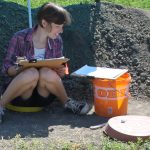 Anna Szigeti
Anna Szigeti
Eötvös Loránd Tudományegyetem
“An examination of changing Copper and Bronze Age trade networks in the Körös River Valley, Southeast Hungary” by Anna Szigeti, Virág Varga, Viktória Kiss, and Attila Gyucha:
Metal is a unique raw material which societies in some parts of southeastern Europe have been exploiting since the Middle Neolithic (5500/5400-5000/4900 BCE). As previous studies in various parts of the world suggest, the acquisition and circulation of metal objects, as well as the ability to work metal have been important in the development of prehistoric societies. In our study, we compared the distribution of metal artifacts during the Hungarian Copper Age (4500/4400-2800/2700 BCE) and Bronze Age (2800/2700-900/800 BCE), focusing on Békés County. We linked these distribution patterns to trade routes in the Körös River region, analyzing the differences in the sources of copper ore utilized at different times. Based on their chemical composition, we then determined the origin of the metals used to create the bronze artifacts found in the Békés 103 cemetery.
(Abstract submitted to the Society for American Archaeology conference in April 2017)
Research Assistants
Manol is Papadakis
is Papadakis
Lund University
I’m an archaeologist with a specific interest in architectural and landscape heritage management. I hold a master degree in Managing Monuments from the National University of Athens, Greece and am currently undertaking a MSc in Geographical Information Systems at Lund University, Sweden. During the season I was assigned with various tasks, like working with GIS data and historical imagery, and troubleshooting with the project database (bone and ceramic data).
2015, 2016
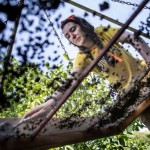 Justine Tynan
Justine Tynan
Quinnipiac University
I was very excited and honored to return for my third year working with the BAKOTA project. I am a History major and an Anthropology minor in the Master of Teaching Grad Program at Quinnipiac University, who started my work with BAKOTA my freshman year in 2012. Now, as a senior, I worked this summer as a lab manager directing the care of the artifacts brought back as well as the documentation coming into the lab. I have been able to develop a research project looking at spatial analysis of ceramic distribution throughout the cemetery in southern Hungary. This project has given me the opportunity to travel, research, work with amazing mentors, and present my work at conferences. I got the chance to present a poster at the Sigma Xi conference held at Quinnipiac University, and will be traveling to Orlando, Florida so the Society for American Archaeology conference this coming Spring.
2014, 2015, 2016
 Kylie Williamson
Kylie Williamson
University of Florida
I was excited to join the BAKOTA project and grateful for the opportunity to explore my interests in bioarchaeology. This summer was my first true experience in the field and although I enjoyed every minute in the field, my favorite part was micro-excavating the burial urns in the lab. During my undergrad career at Yale, I received a degree in Anthropology and enjoyed classes in Forensic Anthropology and Human Osteology, with a particular interest in paleopathology. Next fall, I hope to resume my academic career and pursue a higher degree in Anthropology/Bioarchaeology.
2015, 2016
2015 Participants
Francisco Diaz
San Francisco State University
“The szolo of wrath: Hungarian vineyards and land use in the 20th century” by Francisco Diaz:
Understanding the land use and topology of an excavation site is a necessity for an excavation, because much like farming practices can shatter an urn into pieces, the soil itself is also an archaeological artifact that gets affected by modern-day activity. The BAKOTA project is excavating a Middle Bronze Age cemetery in an area lacking indicators of social stratification typical of the Great Hungarian Plain at this time. Cemetery excavation presents some challenges, however, because multiple landowners and a long and varied history of land use parcel the site into archaeological deposits with differing and varied degrees of disturbance. Oral history provides an important source about land use history for explaining the present soil conditions and helping to inform excavation decisions. This paper consolidates information about known cultivation methods and property ownership using QGIS, providing a visual and spatial reference for further investigation. This undertaking not only provides information to help decide future excavation, but benefits public relations and provides a tool for outreach for the BAKOTA project to inform the present-day residents and stakeholders about the archaeological undertaking in their community.
(Poster presented at the Society for American Archaeology conference in April 2016)
Alana Acuff
College of Charleston
“Analysis of possible anatomical order in micro-excavated Bronze Age funerary urn material from Hungary” by Alana Acuff, Jamie Ullinger, and Laszlo Paja:
On-going excavations conducted by the BAKOTA project at the Bronze Age cemetery of Bekes 103 in Eastern Hungary have uncovered 69 human burials, the majority of which are cremated skeletal remains deposited in ceramic urns. Cremains are an often-overlooked archaeological resource as information regarding age at death, sex, and pathologies can be more difficult to assess after a body has been burned. While demographic information may be limited in this context, the stratigraphic distribution of bones within their burial contexts may inform us about the treatment of the deceased and their deposition in the archaeological record. This study sought to identify patterns of anatomical variation internal to discrete micro-strata of one urn, Human Burial 54. Based on a preliminary analysis (Paja et al. 2014), we hypothesized that there would be a concentration of cranial elements within upper levels of the urn, whereas post-cranial elements would be concentrated within lower levels. Bone fragments were evaluated by size, shape, and internal organization to determine anatomical association and statistics were generated for each level. Our results substantiate our hypothesis, with the ratio of cranial to post-cranial elements decreasing in direct correlation with the micro-stratigraphic levels.
(Poster presented at the Society for American Archaeology conference in April 2016)
Edward Bormann
Quinnipiac University
“Munsell vs. Hounsfield? A methodological comparison in assessing cremation temperatures of human bone” by Edward Bormann, Matthew Capece, Laszlo Paja, and Julia Giblin:
The identification of the temperature at which bone was burned is an important technique for both archaeological and forensic applications that deal with cremated skeletal material. Known color changes in burned bone can be systematically quantified using a Munsell Soil Color Book and associated with known temperature ranges at which the material was burned. Non-invasive techniques, such as computed tomography (CT) scanning may be able to provide analogous information for archaeological material prior to excavation. In this study, we compare Munsell data with Hounsfield Units (a measurement of density) from CT scans of cremated human bone from the Bronze Age cemetery Bekes 103, located in Eastern Hungary. Preliminary results indicate that the Hounsfield Unit values increase with bone that was fired at higher temperatures (as identified using the Munsell technique).
(Poster presented atthe Society for American Archaeology conference in April 2016)
Ashley Cercone
SUNY Buffalo
“Ceramics production and trade across the Great Hungarian Plain: Chemical analysis of Bronze Age ceramics from Bekes 103 in Eastern Hungary” by Ashley Cercone and Mark Golitko:
The Bronze Age in Europe is noted for an increase in foreign interaction and trade, yet some areas show few signs of receiving non-local goods. Using chemical analysis of Bronze Age ceramic pastes from the cemetery of Bekes 103 and nearby clay sources, this poster seeks to investigate trade networks and exchange between the people of the site and other areas of the Great Hungarian Plain. Using LA-ICP-MS, we examine the extent of trade and t he degree to which the community participated in the exchange of goods compared to other areas of the Great Hungarian Plain. Combining new data with information from previously excavated ceramics, this project further explores the movement of ceramics on the Great Hungarian Plain by examining whether or not there are differences between graves in terms of acquisition and use of local versus non-local ceramics.
(Poster presented at the Society for American Archaeology conference in April 2016)
Kayla Pio
University of Michigan
“Food offerings and feasting in Bronze Age burial contexts from the Koros region, Hungary” by Kayla Pio and John Marston:
While the collection and analysis of paleo-ethnobotanical material is increasingly common in settlement excavations, it still remains rare in burial contexts. Botanical material from cemeteries can provide important insights into mortuary practices and associative beliefs about the afterlife for investigated populations. Charred food remains may indicate food offerings or feasting around the burial site, as well as social inequality or aspects of the deceaseds personal identity. In the case of the Bronze Age cremations at Bekes 103, the near-absence of preserved paleoethnobotanical material may indicate that the placement of food offerings on the pyre was not customary in the local culture, though rites involving uncharred food offerings or funerary feasts away from the burial site may have occurred. Alternatively, taphonomic processes could have affected the archaeobotanical assemblage. This study examines intra-site patterning to address this possibility as well as ritual variation within the cemetery. In addition, to aid in the interpretation of the charred seed remains that have been recovered, this study places Bekes 103s paleo-ethnobotanical material in comparison with similar assemblages from other European burial and prehistoric settlement contexts.
(Poster presented at the Society for American Archaeology conference in April 2016)
Pranavi Ramireddy
Hampshire College
“Using cremain weight from a Bronze Age cemetery in Eastern Hungary as an indicator of sex” by Pranavi Ramireddy, Jamie Ullinger, and Laszlo Paja:
In well-preserved osteo-archaeological samples, traditional anthropological methods are employed to determine age at death, biological sex, differences in diet, activity level, pathologies, and genetics. Determining sex based on classical anthropological methods such as examining morphological and metric traits is often difficult or impossible with cremains due to fragmentation and post-depositional damage. A previous study conducted by Van Deest et al. in 2013 showed a correlation between cremain weight and sex using a modern sample. At the Bekes 103 site, a Bronze Age cemetery and settlement in Eastern Hungary, 61 burials had been found by the end of the 2014 season, the majority of which are cremations interred in urns. In our study, total cremain weights were analyzed to see if sex could be determined from urns belonging to adult individuals. Weight-based determination of sex was then compared to results based on morphological and metric traits. Results show that weight estimations of biological sex did not match the results from morphological and metric traits when available.
(Poster presented at the Society for American Archaeology conference in April 2016)
 Matthew Capece
Matthew Capece
Quinnipiac University
“Analysis of color and fracture patterns on burned bones from the Bekes 103 Bronze Age cemetery” by Matthew Capece, Tucker Hlad, and Jamie Ullinger:
In this study we use color and fracture patterns of burned bone to reconstruct cremation temperatures and the conditions of the body prior to cremation in highly fragmented skeletal material from a Bronze Age cemetery in Eastern Hungary. Using a Munsell Soil Color Book we were able to qualitatively measure the color of cremains in order to estimate burning temperature. Determining whether or not the body was burned with flesh relied on two methodologies: the analysis of color patterns across the body and the identification of specific heat-related bone fractures. With the majority of bones being a shade of white, it was estimated that the crematory fires likely exceeded 800˚C. Thumbnail fractures along long bones and the prevalence of nonwhite bones on specific areas of the body, such as where two bones articulate, both suggest that the body was cremated while flesh was on the body. Together, these observations indicate that the people of this region during the Bronze Age took care to cremate the dead soon after death and then carefully tended to the pyres, allowing them to maintain such high temperatures.
(Poster presented atthe Society for American Archaeology conference in April 2016)
Tucker Hlad
Columbus State Community College
“Analysis of color and fracture patterns on burned bones from the Bekes 103 Bronze Age cemetery” by Matthew Capece, Tucker Hlad, and Jamie Ullinger:
In this study we use color and fracture patterns of burned bone to reconstruct cremation temperatures and the conditions of the body prior to cremation in highly fragmented skeletal material from a Bronze Age cemetery in Eastern Hungary. Using a Munsell Soil Color Book we were able to qualitatively measure the color of cremains in order to estimate burning temperature. Determining whether or not the body was burned with flesh relied on two methodologies: the analysis of color patterns across the body and the identification of specific heat-related bone fractures. With the majority of bones being a shade of white, it was estimated that the crematory fires likely exceeded 800˚C. Thumbnail fractures along long bones and the prevalence of nonwhite bones on specific areas of the body, such as where two bones articulate, both suggest that the body was cremated while flesh was on the body. Together, these observations indicate that the people of this region during the Bronze Age took care to cremate the dead soon after death and then carefully tended to the pyres, allowing them to maintain such high temperatures.
(Poster presented at the Society for American Archaeology conference in April 2016)
Virag Varga
University of Cincinnati
“A preliminary analysis of the metal finds from Bekes 103” by Anna Szigeti, Virag Varga, and Viktoria Kiss:
Bronze is a central economic and symbolic focus in the European Bronze Age, and the distribution of metals found in Bronze Age burial contexts can suggest differences in wealth. This poster analyzes the bronze artifacts from the site of Bekes 103, a Bronze Age site in Eastern Hungary. Previous work at settlements in this area indicates little social inequality and suggests that metal production was not centralized at larger settlements (fortified tell-sites). Study of the distribution of metals and other exotic goods in funerary contexts provides an additional avenue for understanding the circulation of exotic goods. So far, excavation at this cemetery produced mostly pins and arm rings, common body ornamentation of the time. In this paper, we consider the distribution, spatial arrangement, and sex and age of the recipients of these finds. We attempt to understand whether the funerary display of bronze differed in this region compared to neighboring areas, suggesting more equal access to resources.
(Poster presented at the Society for American Archaeology conference in April 2016)
Dylan Kelly
University of New Hampshire
“Geophysical investigations at the Bronze Age site of Bekes 103 in Eastern Hungary” by Dylan Kelly and Pawel Dziechciarz
In archaeological research both non-invasive and weakly invasive methods are often employed without, or prior to, excavation. Surface collection, geophysical survey and shovel testing are the methods that have been employed at the site of Bekes 103. Despite the difficulty imposed by the soil conditions and the nature of the targets themselves (cremation graves), geophysical measurements employing a variety of techniques (gradiometry, soil resistivity and electromagnetics) were applied in tandem with surface collection methods to detect potential targets for guiding subsequent excavations. This report merges geophysical data collected in 2015 with the data from the 2011 and 2013 field seasons, comparing the geophysical survey anomalies with the corresponding excavation data. We build a signature archive for cemetery features based on these methods, and through correspondences we isolate potential targets for future excavation. Finally, we tentatively conclude which geophysical prospection methods are optimum for the detection of human burials in this region.
(Poster presented at the Society for American Archaeology conference in April 2016)
CEI (Central European Institute) students
Paw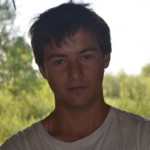 el Dziechciarz
el Dziechciarz
University of Warsaw
“Geophysical investigations at the Bronze Age site of Bekes 103 in Eastern Hungary” by Dylan Kelly and Pawel Dziechciarz:
In archaeological research both non-invasive and weakly invasive methods are often employed without, or prior to, excavation. Surface collection, geophysical survey and shovel testing are the methods that have been employed at the site of Bekes 103. Despite the difficulty imposed by the soil conditions and the nature of the targets themselves (cremation graves), geophysical measurements employing a variety of techniques (gradiometry, soil resistivity and electromagnetics) were applied in tandem with surface collection methods to detect potential targets for guiding subsequent excavations. This report merges geophysical data collected in 2015 with the data from the 2011 and 2013 field seasons, comparing the geophysical survey anomalies with the corresponding excavation data. We build a signature archive for cemetery features based on these methods, and through correspondences we isolate potential targets for future excavation. Finally, we tentatively conclude which geophysical prospection methods are optimum for the detection of human burials in this region.
(Poster presented atthe Society for American Archaeology conference in April 2016)
Gergo Liptak
University of Szeged
Land use conditions affect the quality and preservation of cultural deposits on archaeological sites, and both regional historical data and information gathered from local informants can help archaeologists interpret local features and understand the preservation of sites. This study presents some background for the history and land cultivation methods throughout history at the site of Bekes 103 in Eastern Hungary. The study focuses on how ownership changed over time and the kinds of cultivation techniques land owners used. General information from monographs formed an initial basis for understanding the local history of the site, but this information was complemented and corrected through interviews with locals and field owners in and around the site.The early history of Bekes County suggests that people used the land within the Bekes 103 site for grazing animals (horses, sheep, and cows) from the early medieval times till the Turkish occupation. The first signs of serious land cultivation came from the 17th century, follow up there were acres of vineyards till the communist collectivization. So, examining our knowledge, we can say that the Bekes 103 site has been fully plowed, which is confirmed by reports from the locals too. Surely, this is the reason why in most of the cases the urns are damaged.
Anna Szigeti
University of Szeged
“A preliminary analysis of the metal finds from Bekes 103” by Anna Szigeti, Virag Varga and Viktoria Kiss:
Bronze is a central economic and symbolic focus in the European Bronze Age, and the distribution of metals found in Bronze Age burial contexts can suggest differences in wealth. This poster analyzes the bronze artifacts from the site of Bekes 103, a Bronze Age site in Eastern Hungary. Previous work at settlements in this area indicates little social inequality and suggests that metal production was not centralized at larger settlements (fortified tell-sites). Study of the distribution of metals and other exotic goods in funerary contexts provides an additional avenue for understanding the circulation of exotic goods. So far, excavation at this cemetery produced mostly pins and arm rings, common body ornamentation of the time. In this paper, we consider the distribution, spatial arrangement, and sex and age of the recipients of these finds. We attempt to understand whether the funerary display of bronze differed in this region compared to neighboring areas, suggesting more equal access to resources.
(Poster presented at the Society for American Archaeology conference in April 2016)
Agata Kostrzewa
University of Warsaw
“Osteoarchaeological assessment of generalized stress indicators in skeletons from the Tape-Szenteglaegeto cemetery, Hungary” by Agata Kostrzewa and Laszlo Paja:
Generalized stress indicators are non-specific anomalies produced by the body as an adaptive response to biological stressors such as malnutrition, disease or trauma. The prevalence of these lesions may be related to daily activity, lifestyle or differential access to resources. Based on archeological analyses, the Hungarian Bronze Age is associated with significant socio-economic changes, including population increases, agricultural intensification, and the emergence of social inequality. In this study, burials from the Late Bronze Age cemetery Tape-Szenteglaegeto are used to evaluate whether differential burial treatment is associated with increased prevalence of generalized stress indicators and perhaps differing quality of life. Individuals were chosen based on associated grave goods (high prevalence and low prevalence). Remains were analyzed using macromorphological methods for recording stress indicators like cribra orbitalia and cribra cranii, linear enamel hypoplasia, periostitis, endocranial lesions and superficial vertebral changes. Macroscopically visible bone pathologies were also recorded.
(Poster presented at the Society for American Archaeology conference in April 2016)
 Adam Balazs
Adam Balazs
Miskolc University
“Rogue utopians or bumpkins on the margin? Bronze Age mortuary customs in the marshlands of the Great Hungarian Plain” by Gyrgyi M. Parditka, Paul R. Duffy, Laszlo Paja, Adam Balazs and Justine Tynan:
Bronze is a central economic and symbolic focus in the European Bronze Age, and the distribution of metals found in Bronze Age burial contexts can suggest differences in wealth. This poster analyzes the bronze artifacts from the site of Bekes 103, a Bronze Age site in Eastern Hungary. Previous work at settlements in this area indicates little social inequality and suggests that metal production was not centralized at larger settlements (fortified tell-sites). Study of the distribution of metals and other exotic goods in funerary contexts provides an additional avenue for understanding the circulation of exotic goods. So far, excavation at this cemetery produced mostly pins and arm rings, common body ornamentation of the time. In this paper, we consider the distribution, spatial arrangement, and sex and age of the recipients of these finds. We attempt to understand whether the funerary display of bronze differed in this region compared to neighboring areas, suggesting more equal access to resources.
(Poster presented at the Society for American Archaeology conference in April 2016)
Research Assistants
Dominika Maja Kossowska![10 Aug 2015 (3)[1]](http://bakota.net/wp-content/uploads/2015/09/10-Aug-2015-31-150x150.jpg)
University of Warsaw
Man olis Papadakis
olis Papadakis
Lund University
I’m an archaeologist with a specific interest in architectural and landscape heritage management. I hold a master degree in Managing Monuments from the National University of Athens, Greece and is currently undertaking a MSc in Geographical Information Systems at Lund University, Sweden. During the season I was assigned with various tasks, like working with GIS data and historical imagery, and troubleshooting with the project database (bone and ceramic data).
Kimi Swisher
University of Michigan
Justine Tynan
Quinnipiac University
I was very excited and honored to return for my third year working with the BAKOTA project. I am a History major and an Anthropology minor in the Master of Teaching Grad Program at Quinnipiac University, who started my work with BAKOTA my freshman year in 2012. Now, as a senior, I worked this summer as a lab manager directing the care of the artifacts brought back as well as the documentation coming into the lab. I have been able to develop a research project looking at spatial analysis of ceramic distribution throughout the cemetery in southern Hungary. This project has given me the opportunity to travel, research, work with amazing mentors, and present my work at conferences. I got the chance to present a poster at the Sigma Xi conference held at Quinnipiac University, and will be traveling to Orlando, Florida so the Society for American Archaeology conference this coming Spring.
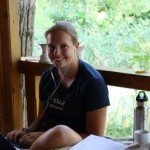 Kylie Williamson
Kylie Williamson
Yale University
I was excited to join the BAKOTA project and grateful for the opportunity to explore my interests in bioarchaeology. This summer was my first true experience in the field and although I enjoyed every minute in the field, my favorite part was micro-excavating the burial urns in the lab. During my undergrad career at Yale, I received a degree in Anthropology and enjoyed classes in Forensic Anthropology and Human Osteology, with a particular interest in paleopathology. Next fall, I hope to resume my academic career and pursue a higher degree in Anthropology/Bioarchaeology.
 Kalyan Chakraborty
Kalyan Chakraborty
University of Toronto
I’m a Ph.D. student in the Department of Anthropology at the University of Toronto, working on reconstructing Harappan subsistence economy from the Indus Borderland using molecular residue analysis. This was my second year excavating with the BAKOTA team. As the field spatial expert, I collected x, y, and z data throughout the excavation using a Total Station and an RTK. I also took spatially referenced photos of burials and features, and used photogrammetry software to create virtual 3D models in the lab. While digging is my passion, I’m currently working on the post-excavation analysis of archaeological materials.
Kelly Gillikin
University of Michigan
I am a graduate from the University of Michigan and currently getting my MSC in archaeology at the University of Edinburgh. I was also part of the art crew with Dori Kekegyi, where I assisted with the drawing and illustrating of reconstructed burial vessels as well as drawing maps of the wall stratigraphy of the site blocks.
Student Participants: 2011-2014
Aleksa Alaica, Maria Búth, Gabriella Kaszás, Vera Dolgos, Patrick Druggan, Brigitta Ecsedy, Natale Fuller, Katherine Haas, Livija Ivanovaite, Gabi Kaszás, Viktoria Körösi, Jake London, Csenge Márkus, Mallory Matsumoto, Enikő Mikusi, Rachel Orsborn, Ádam Pátkai, Kyra Pazan, Danielle Riebe, Lauren Upton, Justine Tynan, Lauren Tosti.





